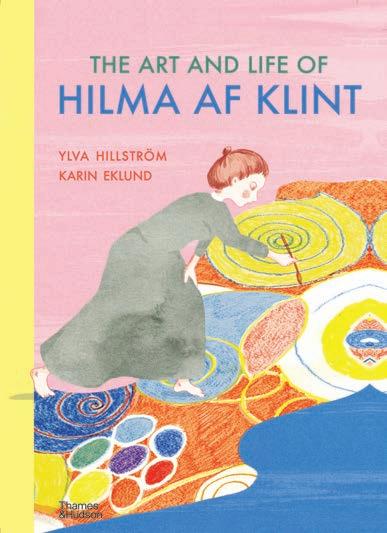
16 minute read
Non-Fiction
Ylva Hillström is a curator at the Modern Art Museum in Stockholm. She was involved in the major Hilma af Klint exhibition in Stockholm in 2013. Karin Eklund has an MA in Children’s Book Illustration from Cambridge School of Art. She wrote and illustrated the book Kids Yoga, which was long-listed for the CILIP Carnegie Medal in 2018.
Illustrated in colour throughout 28 x 21cm 64pp Hardback ISBN 978 0 500 653173 Thames & Hudson Ltd August £14.99
The Art and Life of Hilma af Klint
Ylva Hillström Illustrated by Karin Eklund
For ages 8+
The first children’s picture book on Hilma af Klint and her pioneering work
Hilma af Klint (1862–1944) began painting her abstract and highly symbolic images as early as 1906, long before Kandinsky and Malevich arrived at what is generally regarded as the birth of modern abstract art. She was heavily influenced by spiritual ideologies and claimed that she painted on instruction from the spirit world, for the future. Until recently overlooked by art historians, she is now lauded around the world, and will be the subject of a major exhibition at Tate Modern in 2023. This book is not only about Hilma af Klint’s art, but also about the magic that surrounded her. Brimming with quality reproductions of the artist’s work and with illustrations by Karin Eklund, it will appeal to all children wanting to learn more about the thrilling life and work of this groundbreaking artist.



Wig makers are hard at work in here, creating amazing hairstyles! A wig can transform a dancer or opera singer into their character. Look, there’s the Sugar Plum Fairy’s wig sprinkled with colourful glitter. It sparkles under the stage lights as she dances her pas de deux. The wig team create more than 3,000 new wigs each year as well as looking after more than 100,000 wigs already in the collection. They also make hats, jewellery and tiaras to add the finishing touches to the performers’ incredible outfits.
Six to eight weeks before a show starts, the wig team create a mould of a performer’s head so that their wig can be made the right size and shape. The wig sits on a rounded ‘wig block’ to keep its shape while it is being styled and stored. Each wig takes over a week to make. After a production is finished, wigs are carefully brushed, shampooed and conditioned before being reset with rollers. Rollers are used to help create waves in the hair and to shape it into different styles.
8
Most styles of wig are made from human hair. Asian hair is used for very long styles. Natural blonde or white wigs are made from European hair. Wigs that have tall, complicated styles are not made from human hair, but yak hair.
The Queen of Hearts from Alice’s Adventures in Wonderland has a bright red wig styled into a heart-shaped bun.
The Mad Hatter wears a bright green top hat and a shocking pink wig. Carabosse, the wicked fairy in The Sleeping Beauty, has a wig of black curls and ringlets with a pair of sharp, pointed horns attached.
The White Rabbit’s wig is shaped to look like a pair of rabbit ears.
The Queen of the Night from The Magic Flute wears an elaborate black wig and a wire crown. Her black veil is decorated with crystals which sparkle like stars in the night sky.
Costume jewellery is made from inexpensive metals, stones, sequins and wire. Clara, the heroine of The Nutcracker, wears a necklace made from imitation pearls.
I love purrrrls!
9
Let the show begin!
Encore! How can I get involved?

Sadly, the performance is over, but don’t worry, it doesn’t have to end here. There are plenty of ways that you can get involved in ballet or opera. Perhaps you want to be a dancer or a singer? Or maybe you would like to be a conductor, a set designer or a stage manager? Whatever it is you fancy doing, you can start learning the skills.

Why not try taking a ballet or dance class? If you are really serious about becoming a member of a ballet company it is going to take a lot of training and hard work.
Joining an art club will teach you lots of skills that you could use as a prop or set designer. There are also plenty of projects that you could try at home. How about building your own set from cardboard boxes? Or have a go at making some fake food from papier-mâché! If you would like to be in an orchestra you’ll need to learn an instrument. First, think carefully about what you’d like to play. Why not try asking your school if you can try one or two instruments before you decide? Then practise, practise, practise!
Becoming a member of a junior choir is a great way to start singing and learn to read music. If you don’t have a choir near you, ask your school if you can start one with some friends.
If you have a big imagination and love being creative, then working in the costume department could be the job for you. Why not make an outfit for your favourite character from old clothes or material you have at home?
35

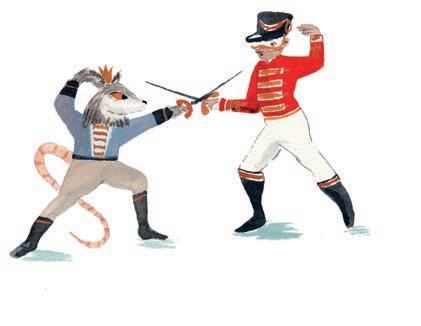
Lauren O’Hara lives in Dublin. She is the illustrator of Sophie Dahl’s children’s book Madame Badobedah, which was a Sunday Times Children’s Book of the Year and has been nominated for the Kate Greenaway Medal twice. With her sister Natalia O’Hara as author, she illustrated Hortense and the Shadow and The Bandit Queen.
40 colour Illustrations 29.5 x 24.5cm 40pp Hardback ISBN 978 0 500 652510 Thames & Hudson Ltd August £12.99
Curtain Up!
Behind the Scenes at the Royal Opera House
Illustrated by Lauren O’Hara For ages 7+
Figaro the cat takes readers on a backstage tour of London’s magnificent Royal Opera House
It’s opening night of The Nutcracker and the ballet dancers, singers and performers at the Royal Opera House are getting ready to step out into the spotlight. Backstage a team of craftspeople, designers and engineers are working against the clock, preparing for the director to say, ‘Curtain up!’. Figaro the cat takes readers on a backstage tour to discover what it takes to put on a performance. Featuring examples from key works of opera and ballet, highlights include trying on the Mad Hatter’s wig from Alice in Wonderland; practising a fighting scene from Romeo and Juliet; perfecting the Sugar Plum Fairy’s tutu; learning to ‘play dead’; and creating explosions on stage. With an introduction to a classical orchestra, key ballet terms and basic stage directions, the book encourages readers to explore the many ways they can get involved.
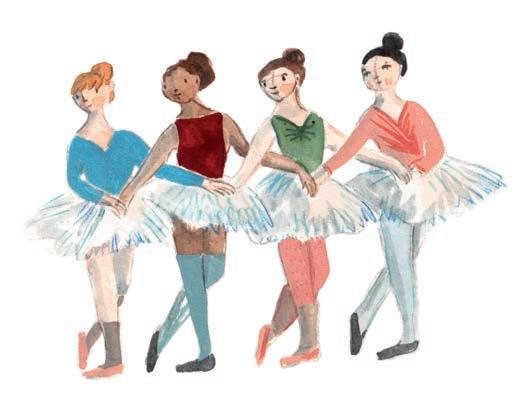
Dame Darcey Bussell, former Principal Ballerina with The Royal Ballet
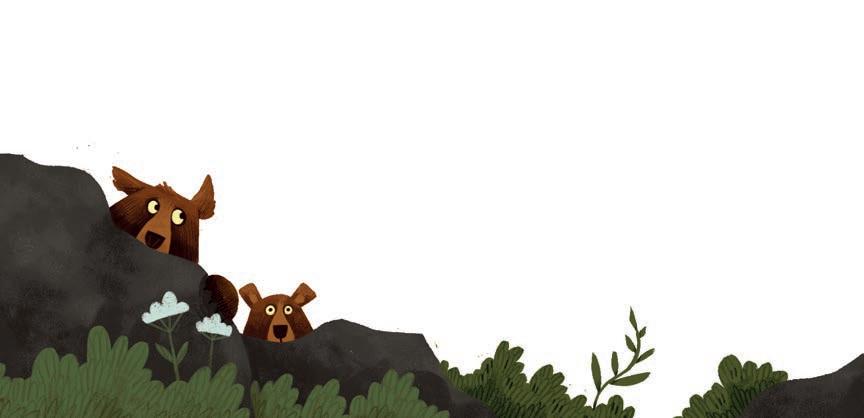

Illustrated in colour throughout 30 x 23cm 48pp Hardback ISBN 978 0 500 652763 Thames & Hudson Ltd August £12.99 Huw Lewis Jones is a polarexploring author and naturalist who is lucky enough to have met many bears in the wild. He is Associate Professor at Falmouth University, and has written history books about photography, icebergs, mountains and maps. He is also the author of the Bad Apple book series. Sam Caldwell is an illustrator based in Glasgow, Scotland. He studied painting at the Edinburgh College of Art and is the illustrator of four books for children, including Weird, Wild, Amazing!.

Do Bears Poop in the Woods?
Huw Lewis Jones Illustrated by Sam Caldwell For ages 6+
Field guide Huw Lewis Jones takes readers out into the wild to discover all there is to know and love about the eight different species of bears
Do you know your panda from your polar bear? Can you spot the difference between a sun bear and a sloth bear? Follow your expert field guide as we travel deep into the woods to learn all the ‘bear’ necessities. Bears are familiar to us all, but what you might not realise is that behind their big, grizzly image are wild animals who really need our help. So put on your walking boots, grab your binoculars and come along on a journey to see the eight incredible bear species in the wild. Not only will you discover why bears poop so much, you’ll also find out how to avoid getting eaten by one, and what we can do to protect them.






Mary Richards is a publisher, author and illustrator. She is the author of numerous books for children, including the bestselling A History of... series and Splat!: The most exciting artists of all time (both Thames & Hudson). Rose Blake is an award-winning artist and illustrator who has illustrated many books for children and adults, including the A History of... series.
Illustrated in colour throughout 27.9 x 21.6cm 96pp Hardback ISBN 978 0 500 652824 Thames & Hudson Ltd August £14.99

A History of Words for Children
Mary Richards Illustrated by Rose Blake For ages 7+
A history of the world told through the prism of language, from Shakespeare to Anne Frank, Martin Luther King to Greta Thunberg
From hieroglyphs to haiku, sign language to Shakespeare, humans have invented endless ways to communicate using words. Written in a lively narrative style, A History of Words for Children explores human development through the prism of language, introducing readers to the civilizations, inventions and wordsmiths who have shaped the way we communicate. The book explores what words are and how humans communicate using spoken language and sign; the development of written scripts and writing implements, including paper; the history of manuscripts and printed books, including worldwide bestsellers and famous libraries; the process of learning another language; dialects and accents and the way they reflect our identity; the power of words to calm, inspire, rally crowds and rule nations; graffiti’s role in spreading messages; codes and invented languages; the patterns of poetry; the future of words, including emojis; and languages facing extinction.
Also available
Winner of the BolognaRagazzi New Horizons Award 2019
‘This trove of a book is … to be cherished’
Daily Telegraph
Mark Ellen
1. The First Word
14 Born to Talk

Our brains and bodies are designed so that, from a very
young age, we try to communicate with others. We might do this by making and copying sounds, creating different facial expressions or using our body movements to get across what we are thinking and feeling. Most importantly, we also use our brains to interpret and understand those actions. Let’s think about the way many babies learn to talk. In the first weeks of their life they will make a few different noises, which might at first sound like nonsense. But by the age of 2 or 3 they are able to put together strings of words and even talk in sentences. Put together, these groups of sounds and words make a language. Languages can sound very different, and speakers around the globe use their mouths, tongues and throats in different ways – from click languages like Xhosa (which is one of many languages spoken in South Africa – it includes a series of ‘clicking’ sounds) to European languages like German (whose ‘rolled’ ‘R’ is produced in the back of the mouth). But wherever we live on the planet, the way we learn language is the same. Our neurons (the tiny electronic messengers in our brains) fire up and make new connections and pathways. As we’ll go on to discover later in this book, the skills of reading and writing were invented many, many years later after humans learned to speak – and they take a little longer to master. Still, by the time we are 7 or 8 years old, we can recognise hundreds of characters and words. Fast forward ten years, and we are able to understand even trickier texts and ideas. In fact, our flexible human brains are designed so that we never stop learning.


3. Reading Words ONCE UPON

A TIME...
Reading Stories
What stories do you like reading? Do you like tales where
characters go on an epic adventure? Fantastical stories where animals speak and humans have magical powers? Or perhaps you prefer real-life tales set in an actual historical place?
For centuries, and in lands across the world, stories have started with phrases like: ‘Once Upon A Time…’ or ‘A Long Time Ago…’ These words tell the reader that they must leave behind what they know, and get ready to enter a new, exciting world. When we open a book and start reading, we bring our own experiences with us. We think of all the stories we’ve ever read, and compare the lives and actions of the story characters with our own. This is what makes every book different for every reader. Scholars have noticed that many of the world’s most popular stories have quite a similar structure. The plots of some popular stories can be traced right back to one of the first recorded stories, the 4,000-year-old Epic of Gilgamesh – which tells of the adventures of the hero-king of Uruk as he searches for the secret of eternal life. One scholar, Joseph Campbell, wrote a book that explored myths and legends from around the world, and noted what they all shared – the journey of a hero and their return with new insights or powers. He called it The Hero With A Thousand Faces (1949). Inspired by that book, George Lucas used its ideas to write a rather famous film script – Star Wars.
Can you think of any other books that tell stories of heroes, quests and returns? Maybe you’ll write one yourself, one day.
‘WORM’
REFERS TO AN OBSOLETE GROUPING,
‘VERMES’ USED BY CARL L INNAEUS AND JEAN-BAPTISTE LAMARK FOR ALL NON-ANTHROPOD INVERTEBRATE ANIMALS, NOW SEEN TO BE POLYPHYLETIC.
TAXONOMY OF WORMS
WORM FACTS 1. The First Word
15
THE FIRST WORD
How do we use words?
I’m a blue whale. I talk to my friends using a range of deep, groaning sounds – and they can sometimes hear me up to 1,000 miles away!
I’m Helen Keller. I lost my senses of sight and hearing when I was 19 months old. I learned to speak, read and write, and was the author of many books.
I’m Christine Sun Kim. I make art about the way people communicate.
GO! GO!
GO!
3. Reading Words
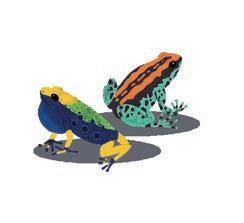


Ico Romero Reyes worked at New York’s American Museum of Natural History for over six years, but now lives in Barcelona. She is passionate about producing content for kids and teens. Tània García is an acclaimed illustrator and designer from Barcelona. Her book Uno, Un Millón was shortlisted for the AOI’s World Illustration Awards 2021 in the Children’s Publishing category.
Illustrated in colour throughout 32 x 25.7cm 48pp Hardback ISBN 978 0 500 652916 Thames & Hudson Ltd November £12.99

Toxic
The World’s Deadliest Creatures
Ico Romero Reyes Illustrated by Tània García For ages 7+
An entertaining and beautifully illustrated survey of the use of poison in the animal kingdom
Creatures from all around the animal kingdom wield a mysterious weapon that is key to their survival: poison! Their sophisticated concoctions are designed with precision to defy predators or subdue prey. This spine-tingling collection of toxic animals will teach children about the astonishing strategies they use to deliver venom and poison, from big-eyed fuzzy critters with a poisonous secret or tiny flashy octopuses that can kill in minutes, to sinister spiders, snakes and scorpions. The book includes a feature on a day in the life of a toxicologist, and children can test their knowledge with the quiz that concludes the book.
The Beasts Poison Dart Frogs • Venomous Mammals Coral and Sea Anemones • Toxic Birds Gila Monsters • Greater Blue-Ringed Octopus Snakes • Jellyfish • Toxic Fish • Ants • Spiders Scorpions • Cone Snails

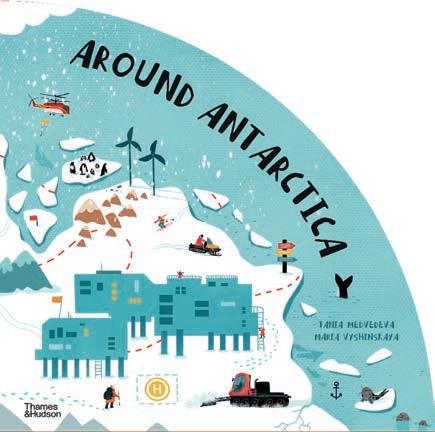
Tania Medvedeva is a STEAM expert and author of several popular science books for kids. She is a polar enthusiast and is currently investigating the impact of global warming on Antarctica. Maria Vyshinskaya graduated from the Moscow State University of Printing with a major in the art of book graphics, and has contributed illustrations to several publications.
Illustrated in colour throughout 26 x 26cm 72pp Hardback + four fold-outs ISBN 978 0 500 653135 Thames & Hudson Ltd August £16.99
Around Antarctica

Tania Medvedeva Illustrated by Maria Vyshinskaya For ages 8+
A unique, fold-out book of popular science on Antarctica
John, an intrepid journalist, has long dreamt of visiting Antarctica – and at last his dream is coming true. He’s off to Antarctica as part of a scientific expedition. This fold-out book follows him on his journey as he learns all about this amazing continent and the people who work there. It includes interviews with real-life polar explorers, who underline the deadly impact of global warming on this beautiful environment. Accessibly written and based on multiple scientific sources and studies, and brimming with detailed, colourful illustrations, this factfilled, fold-out book will be essential reading for all budding environmentalists and explorers.

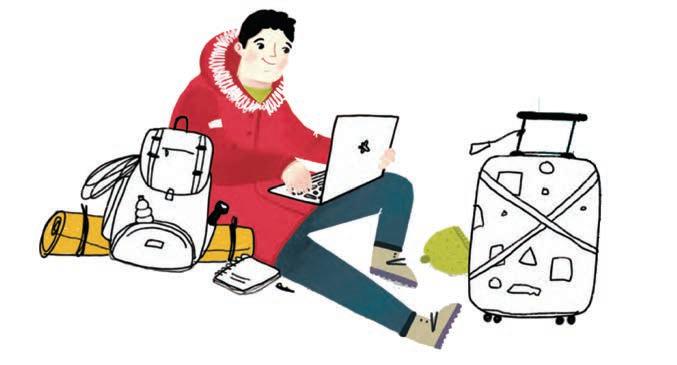
ThamesandHudsonAsia
Asia
Thames & Hudson Asia Limited
Units B&D, 17/F, Gee Chang Hong Centre, 65 Wong Chuk Hang Road, Aberdeen, Hong Kong Tel: 852 2553 9289 | Fax: 852 2554 2912 WhatsApp: 852 6882 1702 Website: www.asiapubs.com.hk To Order: orders@thameshudson.asia Enquiry: enquiries@thameshudson.asia



